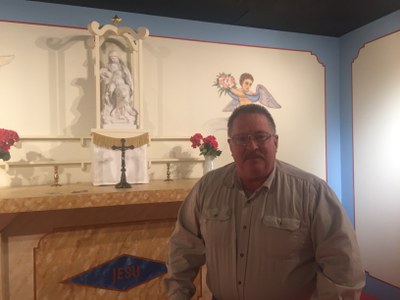
Purchase Tickets
A Member’s Idea Brings a Chapel to Life

“It’s more than just a military installation,” says longtime IHS member Roy Zenor about Camp Atterbury. “It’s part of a bigger family that goes back to before there was a Hoosier State.” And Roy is certainly part of that family. He was a National Guard soldier for 22 years, and in and out of Atterbury on weekends and during active training periods. In 2002, he worked there full-time helping to mobilize soldiers and working in morale, welfare and recreation. He retired from the National Guard in 2010, and officially retired in 2015 after doing everything from preparing State Department employees going overseas to overseeing cadets at a military prep school in Kentucky.
Roy attended the You Are There: That Ayres Look exhibit opening at the History Center and bent the ear of Museum Theater Director Daniel Shockley, who had never heard about Camp Atterbury’s Chapel in the Meadow, built by Italian POWs. Roy began the conversation with, “What do you know about Camp Atterbury?” That simple query led to a field trip to the still-standing chapel, and a You Are There was born. “We just fell in love with the story,” says Dan.
Roy has been a member of IHS since he was in the Indiana Junior Historical Society back in the 1960s and 1970s. He comes by his love of history naturally. “My dad was head of the history department at George Washington High School in Indianapolis, involved in IHS and the Civil War Roundtable, and director of the Indiana Sesquicentennial,” he says. “As a 12-year-old, I traveled with him all over the state. That time helped instill my love for Indiana and its history. If we don’t connect to the past, we don’t have a clear view of the future.”
His connection to Camp Atterbury is deep as well. “My dad mobilized through Atterbury in 1945 to Japan, and my uncle was one of the original carpenters who helped build it in 1942.”
Three thousand Italian prisoners were housed at the camp during World War II. Roy’s first view of the Chapel in the Meadow was from a helicopter. “It’s interesting because there are a lot of soldiers – both Indiana guardsman and other soldiers who came through Camp Atterbury – who never knew we had Italian and German POWs there,” says Roy. “And even the ones who knew had no idea how many we had there or how long they were there.”
The chapel was built on the POWs’ own time using scavenged materials, including berries and other fruit to make the paint. “Most people have a picture of a POW camp that is of how our soldiers were being treated overseas,” says Roy. “There was a particular soldier from Italy who remarked one time that if he and his brother would have known how good they would have it at Camp Atterbury, they would have surrendered months earlier.”
The POWs had an influence on the community surrounding the camp. Many American men and boys were in the military overseas, and the farms received help from the POWs who, in some cases, became family. “Most of those soldiers didn’t want to be in the military – they were forced to,” he says of the Italian men. “It was amazing to see how quickly they supported what was going on as well as the support they got from the camp, from the military and from the community.”
When he’s not coming up with ideas for our exhibits, Roy loves learning about history, reading Civil War novels and traveling all around our beautiful state on his trike motorcycle. “We take it on afternoon rides. It’s the diversity in the geography of the state that keeps my interest.”








